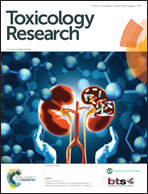In vitro toxicity evaluation of silica-coated iron oxide nanoparticles in human SHSY5Y neuronal cells
Abstract
Iron oxide nanoparticles (ION) have been widely used in biomedical applications, for both diagnosis and therapy, due to their unique magnetic properties. They are intensively explored in neuromedicine mostly because of their ability to cross the blood brain barrier. Hence, their potential harmful effects on neuronal cells need to be carefully assessed. The objective of this study was to evaluate the toxicity of silica-coated ION (S-ION) (10–200 μg ml−1) on human neuronal SHSY5Y cells. Alterations in the cell cycle, cell death by apoptosis or necrosis, and membrane integrity were assessed as cytotoxicity parameters. Genotoxicity was determined by a γH2AX assay, a micronucleus (MN) test, and a comet assay. Complementarily, possible effects on DNA damage repair were also analysed by means of a DNA repair competence assay. All analyses were performed in complete and serum-free cell culture media. Iron ion release from the nanoparticles was notable only in complete medium. Despite being effectively internalized by the neuronal cells, S-ION presented in general low cytotoxicity; positive results were only obtained in some assays at the highest concentrations and/or the longest exposure time tested (24 h). Genotoxicity evaluations in serum-free medium were negative for all conditions assayed; in complete medium, dose and time-dependent increase in DNA damage not related to the production of double strand breaks or chromosome loss (according to the results of the γH2AX assay and MN test), was obtained. The presence of serum slightly influenced the behaviour of S-ION; further studies to investigate the formation of a protein corona and its role in nanoparticle toxicity are necessary.


 Please wait while we load your content...
Please wait while we load your content...